Project unearths silent witnesses to history
By Rosanna Galvin
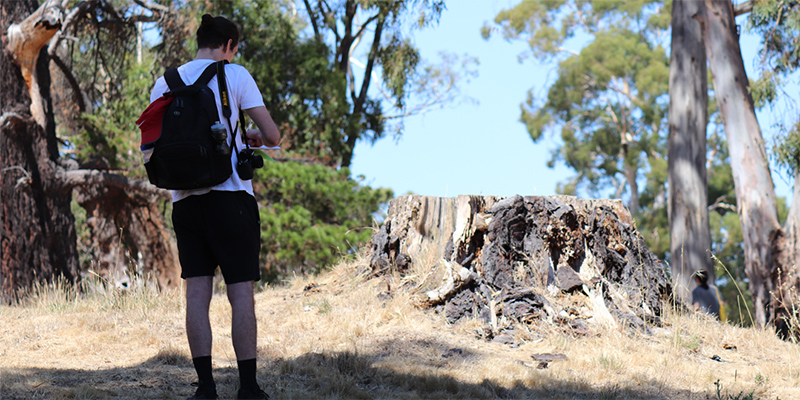 ART AND DESIGN Students used trees in Adelaide as living artefacts to study in an immersive Witness Tree Project.
ART AND DESIGN Students used trees in Adelaide as living artefacts to study in an immersive Witness Tree Project.From the iconic Australian gum to the introduced jacaranda, the trees that characterise the landscape around us have often witnessed more history than we could ever imagine.
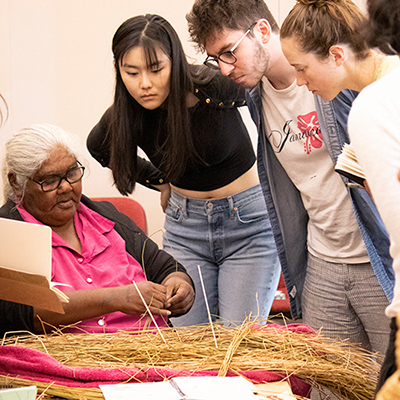 Students also learnt about the use of ancient red gums by Aboriginal peoples for canoes, bowls, medicine, and marking.
Students also learnt about the use of ancient red gums by Aboriginal peoples for canoes, bowls, medicine, and marking.In an Australian first, students from UniSA and the Rhode Island School of Design (RISD) used the trees in Adelaide as living artefacts to study in an immersive Witness Tree Project.
Developed in the United States 11 years ago at RISD – one of the top design schools in the world – the ongoing project combines the disciplines of art and design practice, history and social sciences to provide a new perspective on the past.
UniSA designer Peter Walker says he worked with RISD's Dale Broholm and Daniel Cavicchi to develop the Adelaide-based course, which explores the key events, trends, and sociocultural developments living trees in South Australia have seen.
“Students from a wide range of disciplines participate in a joint history seminar and creative studio focusing on history, place and public memory. What results from this exploration is new cultural perspectives unique to our history,” he says.
“For example, when European settlers arrived in the area that is now Adelaide, Australia, home to the Kaurna Aboriginal nation, they brought with them ideas about the environment that literally altered the landscape and the fate of the Kaurna people and culture.”
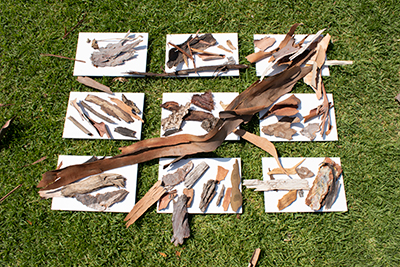 Collaborative Mapping Project by Louis Hand (Industrial Design, RISD) and Heloise Schioldann (Architecture, UniSA).
Collaborative Mapping Project by Louis Hand (Industrial Design, RISD) and Heloise Schioldann (Architecture, UniSA).The project used selected trees of South Australia located in Adelaide’s Botanic Gardens, from the ancient red gum used by Aboriginals for canoes, bowls, medicine, and marking, to the English oak and other non-native species introduced by settlers to shape the controlled aesthetic of Adelaide’s many parks and gardens.
Following the seminar, research and fieldwork component of the project, students created objects for an exhibition at the Museum of Economic Botany that examined the changing indigenous and settler conceptions of the environment, historical dialogues about land, and competing ideologies of place, borders, roots, and movement.
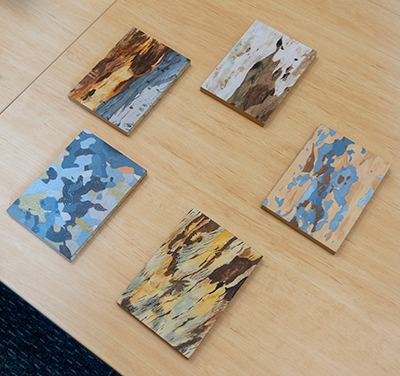 Bark Mapping. A series of painted studies by Asha Southcombe (Contemporary Art, UniSA).
Bark Mapping. A series of painted studies by Asha Southcombe (Contemporary Art, UniSA).One of the 20 students who took part was Jasmine Gutbrod, a Furniture Design major from RISD. She says the study of living trees was eye-opening in her understanding of Australian history, particularly in relation to conflict between European settlers and the Aboriginal population.
“What this project revealed is that trees in the Adelaide area can be used as a record of history and European invasion,” she says.
“In Adelaide you have native species and then the species that are located in places like the Botanic Gardens, for example, which are from all around the world, representing this European, Victorian-era obsession with collection and exploitation of exotic goods.”
Jasmine’s contribution to the exhibition involved printing with seed pods from a variety of tree species including sheoak pods, banksia pods and gumnuts. By using them as drawing tools she hoped to provide new ways to look at ecology and plant species and a different way of recording information about them.
The Witness Tree Project is the brainchild of Broholm and Cavicchi from RISD. Broholm says the Australian version has expanded on the original concept, where RISD works with the United States’ National Park Service on a single fallen tree, which has been identified as significant because of its presence at key moments in American history.
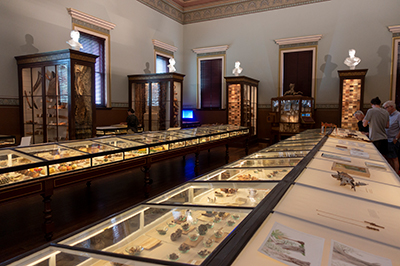 Students created objects for an exhibition at the Museum of Economic Botany.
Students created objects for an exhibition at the Museum of Economic Botany.“It's an experiment that's working out. For our first Australian adaptation, we decided to centre it around various trees as living artefacts and what they have witnessed in the events of South Australia,” he says.
Reflecting on her participation in the project, UniSA Bachelor of Design (Illustration and Animation) student Jodi Moyle says it has been a unique and enriching experience.
“Witness Tree has been about witnessing – really looking, and about art and how it helps us to see,” she says.
“That’s what we have done. We’ve tried to see things we might not have already been able to see.”
Other Stories
- The exercise that will maximise your heart and brain health
- What is the language of love in the 21st century?
- How to take a tiger’s pulse with a digital camera
- Graduates’ visual handiwork on show for the Oscars
- From the Vice Chancellor
- Achievements and Announcements
- Video: Helping nature recover after Cudlee Creek bushfire
- UniSA offers video gamers a chance to realise their dream jobs
- Students tackle some of life’s big questions in new MOD. podcast
- College graduate returns behind teacher’s desk
- Honouring the ‘voice of cycling’
- Swedish internship gives UniSA students a headstart in defence careers
- Project unearths silent witnesses to history
- Bushfire fundraiser, TDU and more




